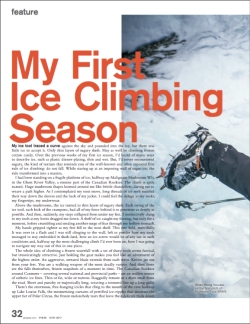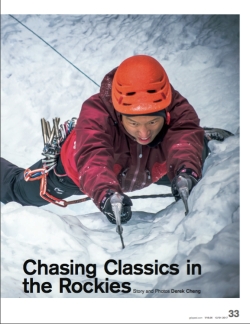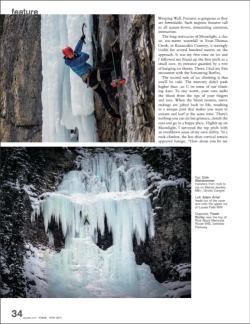Published in Adventure Magazine NZ, June/July 2016, and in Gripped, December 2016

My ice tool traced a curve against the sky and pounded into the ice wall. Except there was little ice to accept it. Only thin layers of sugary slush. May as well be climbing frozen cotton candy.
Over the previous weeks of my first ice season, I’d heard of many ways to describe ice. Plastic. Dinner-plating. Thin and wet. But I’d never encountered sugary, the kind of texture that screams the well-known and often repeated first rule of ice climbing: do not fall. While staring up at an imposing wall of sugar-ice, the rule transforms into a mantra. Don’t fall, don’t fall, don’t fall.
I had been standing on a fragile platform of ice, halfway up (water ice grade) WI5 Malignant Mushroom, in the Ghost River Valley, a wild and remote part of the Canadian Rockies. The climb is aptly named. Huge mushroom shapes loomed around me like brittle chandeliers, daring me to weave a path higher.
As I contemplated my next move, long threads of ice melt nuzzled their way down the sleeves and the back of my jacket. I could feel the deluge in my socks, my fingertips, my underwear.
Above the mushrooms, the ice turned to thin layers of sugary slush. Each swing of the ice tool, each kick of the crampons, had all of my force behind it to penetrate as deeply as possible.
And then, suddenly, my steps collapsed from under my feet. I instinctively clung to my tools as my boots dragged me down. A shelf of ice caught my footing, but only for a moment, before crumbling and sending another surge of fear through my hollow stomach.
My hands gripped tighter as my feet fell to the next shelf. This one held, mercifully. It was over in a flash, and I was still clinging to the wall, left to ponder how my tools managed to stay embedded in slush-land, how an ice-screw would be of any use in such conditions, and, halfway up the most challenging climb I’d ever been on, how I was going to navigate my way out of this in one piece

The whole idea of climbing a frozen waterfall with a set of sharp implements seems farcical, but intoxicatingly attractive. Just holding the gear makes you feel like an adventurer of the highest order. An aggressive, serrated blade extends from each wrist. Knives jut out from your feet. You are a walking weapon of the most deadly variety.
And then there are the falls themselves, frozen snapshots of a moment in time. The Canadian Rockies – covering several National and Provincial Parks – are an endless source of aesthetic ice lines. Thin or fat, wide or narrow. Ruggedly remote, or a short stroll from the road. Short and punchy, or majestically long, weaving a textured line up a long gully.
There’s the enormous, hanging icicles that cling to the mouth of caves, the free-hanging daggers and mesmerising curtains of petrified ice-ripples, the hanging vines of delicately-balanced chandeliers. Features as gorgeous as they are formidable. Such majestic features call to all nature-lovers, demanding attention, interaction.
The long intricacies of Moonlight, a classic 100m waterfall in Evan-Thomas Creek, in Kananaskis Country, is teasingly visible for several hundred metres on the approach. It was my first time on ice, and I followed my friend up the first pitch to a small cave, its entrance guarded by a row of hanging ice thorns.
There, I had my first encounter with the Screaming Barfies. The second rule of ice climbing is: you’ll be cold. The mercury didn’t push higher than -20C on some of our climbing days. To stay warm, your core sucks the blood from the tips of your toes and fingers – especially from your fingers as you raise them to swing your tools. When the blood returns, nerve endings are jolted back to life, resulting in a unique pain that makes you want to scream and barf at the same time. There’s nothing you can do but grimace, clench the eyes, and go to a happy place.
Higher up on Moonlight, I surveyed the top pitch with an overblown sense of my own ability. To a rock-climber, the less-than-vertical terrain appeared benign.
“How about you let me lead the top pitch?” I foolishly asked.
The third rule of ice climbing: it’s always much steeper than it looks. I was soon on what felt like near-vertical terrain, kicking as hard as I could, swinging tools with all my might, driving in screws as often as I could to appease the chants – don’t fall, don’t fall – in my head.
But having just returned from a rock trip, I found the handles of my tools far more amenable than the razor edges I’d been clinging to over previous weeks. Huge holds, wherever you want them, as long as you can smash your tools into the ice, and the ice doesn’t fall apart like pie pastry.
The lack of trust in my crampons made me cling to my tools as if on the edge of a cliff, making the whole climb feel a tad spicy, but exhilarating. Reaching the top felt like total liberation.
I was instantly hooked.

![]()

Day three on the ice. Welcome to dinner-plating.
Shades of Beauty, a WI4 in the Icefields Parkway, Jasper National Park, is a trio of wide ice curtains separated by spacious, comfortable ledges. The first pitches offered superb, plastic ice, which often accepted with glee a single swing of an ice tool. The movement was fluid, flowing, fun.
On the last pitch, my calves started to seize with cramp as I wriggled a screw into the wall. Suddenly, the ice around the screw fractured, splintered, roared with laughter. I kept driving it in with a false sense of hope, until a thick, circular plate of ice detached completely. “Ice!” I yelled as the chunks peeled off and gave in to gravity.
Is this why nobody ever falls on screws, because you never really know how strong the ice is, and you never really want to find out?
This wasn’t exactly confidence-inspiring. I swung both tools with frantic purpose, and drove my crampons as if kicking the life out of a mule. One swing felt good, but I could clearly see a fracture in the ice under the tool. Pull on it, or swing again? I pulled, and the ice plated again, throwing darts at my eyes as I clung to my other tool like the balance of the universe was at stake.
But a moment of reprieve soon cushioned me in its soft bosom. I finally found a good tool placement and stepped up on solid feet, hips close to the wall, and suddenly felt completely stable, my weight almost entirely off my arms. The imminent danger of wetting myself subsided. Next, I discovered that my tool didn’t have to be completely buried in the ice to feel bomber. The tiniest of tips in the shallowest depths of good ice could feel equally secure.
When I topped out onto a large snowy ledge, the gates of euphoria opened and embraced me. Beaming would be an understatement.
The following day, my smile was noticeably absent as I made my way through a maze of bulbous features on Murchison Falls. At one point, my tools firmly in the ice, I hero-cut my feet and swung them up by my hips. It evoked a false sense of invincibility, which was shattered a moment later when I traversed onto an ice shelf that promptly collapsed.
How quickly, and cruelly, the ice can change its mind and provoke a feeling of imminent urination.


The fourth rule of ice climbing is: don’t lose your shit. You may be cold, shivering, saturated. You may be clinging to the edge of life on the tiniest of pricks, in ice as solid as sand, or with more dinner plates than an army banquet. You may be cowering as the climb hurls debris at the tenderest of places (the bridge of the nose is a trigger for instant tears, I discovered). You may be squinting into a windy barrage of flailing snowflakes, unable to see past your fingertips.
But you do yourself no favours by breaking down, panicking, or cursing the future offspring of your belayer, who is trying to offer you words of encouragement.
Sometimes just laughing at the pure ridiculousness of the sport helps to centre you. I chuckled uproariously on Malignant Mushroom as I emptied the bucket-load of water that had pooled in the hood of my jacket, and again as yet another air pocket swallowed yet another useless ice screw, and again as I somehow dropped my last long ice screw. It pirouetted as it drifted to the ground.
After my feet blew through two frail ice shelves in quick succession, I took to placing both my ice tools, and then weighting them with all my heft – feet dangling – before moving up; I also found this an excellent way to rest my calf muscles.
Slowly, move by move, I crept higher, out of mushroom territory and onto the upper wall. The ice remained buried under sugary layers of slush, but I kept moving, each time putting all my weight on my tools before kicking my feet higher.
Near the top of the 55m pitch, as the angle finally relented, a heavy cloud lifted from inside my temples, slowly at first, and then quickly dissipating in a brilliant light that surged from somewhere deep within. At the safety of the chains, I howled at the wild winds, at the moving shades of grey in the sky, at the rugged beauty of the valley.
If you follow all the rules of ice climbing, the elation of the aftermath verges on the transcendent. Reward is proportional to how epic the climb is, and ice climbing is a rare and rich level of epic. Every time you top out feels like you’ve been reborn, redeemed, enriched, as you soak up the exquisite relief, and bask in the sublime magnificence of it all.


It is the last of what has been six weeks of glorious ice and mixed climbing in the Rockies. There have been days that have tested survival instincts and begged the question: what am I doing here? There have been other days of perfect, solid, tool-swallowing ice, sometimes even in the glorious sun, where the Barfies fear to tread.
Today there is considerable avalanche danger in the backcountry, but a handful of accessible crags offer great ice and mixed lines. We’re at Grotto Canyon – a convenient 10-minute drive from Canmore and 20-minute stroll to a trio of frozen falls.
The rules of ice climbing have served me well, but I remain intrigued by rule number one. The tales I’ve heard of falling on ice screws have taken on an almost mythical, mystical status.
We run up the 55m Grotto Falls first, so much more confident than when we first swung tools, and then tackle Sketch and Sniff (mixed grade M6+), a line through a steep rock wall, joining an ice curtain at the top.
“There’s a bolt in the rock on your left,” my belayer Kenny yells at me as I pull onto the ice curtain.
I look over my shoulder at him, grin, and then ignore the bolt and place a screw in the ice. It feels solid, looks solid, so I clip it and climb to the anchor. The screw is now nibbling my toes.
I stare at the screw, at my toes, at the fall line, at the teasing anchor in front of my nose. Don’t let go of your tools. Land softly on your crampons.
Now … let go.
